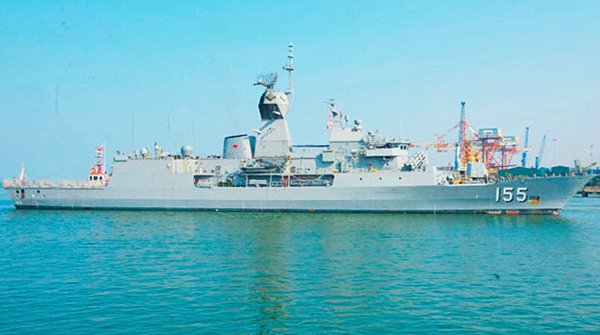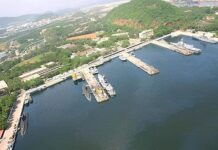
In a significant move that came amid a Sino-India border row, India announced, on 19 October, Australia”s participation in the Malabar exercise, held in November, along with the US and Japan, effectively making it the first military-level engagement between the four member nations grouping – the Quad. Australia’s return shows Delhi is reconsidering deference to Beijing’s interests, giving primacy to its own.
The Malabar exercise aims at interoperability with emphasis on humanitarian assistance, surface war manoeuvres, anti-submarines warfare, counter-terror operations and aerial surveillance. Classically, it is enhancing capabilities of operating jointly in an adverse scenario if the situation so demands.
The invitation by India went out to the Australian Navy two weeks after the foreign ministers of the Quad countries held extensive talks in Tokyo, on 6 October, with a focus on enhancing their cooperation in the Indo-Pacific, a region that has witnessed increasing Chinese military assertiveness.
ALSO READ: JOINT EXERCISES – Quad Navies Hold 24th Malabar Exercise
In the Quad meeting, foreign affairs minister S Jaishankar stated, “We remain committed to upholding the rules-based international order, underpinned by the rule of law, transparency, freedom of navigation in the international seas, respect for territorial integrity and sovereignty and peaceful resolution of disputes.” Jaishankar also emphasized that Quad was aiming for ‘maintaining a free, open, and inclusive Indo-Pacific.’
In her reaction, Australian defence minister Linda Reynolds termed the participation of her country in the exercise a “milestone opportunity” and said it would showcase the “deep trust” between four major Indo-Pacific democracies and their shared will to work together on common security interests.
“High-end military exercises like Malabar are key to enhancing Australia’s maritime capabilities, building interoperability with our close partners, and demonstrating our collective resolve to support an open and prosperous Indo-Pacific,” Reynolds said.
Growing Ties
Defence and security ties between India and Australia have been on an upswing in the last few years. In June, India and Australia elevated their ties to a comprehensive strategic partnership and signed a landmark deal for reciprocal access to military bases for logistics support during an online summit between prime minister Narendra Modi and his Australian counterpart Scott Morrison. India has already inked mutual logistics support deal with the other two Quad members.
The Mutual Logistics Support Agreement (MLSA) allows militaries of the two countries to use each other’s bases for repair and replenishment of supplies besides facilitating scaling up of overall defence cooperation.
In September, the navies of India and Australia carried out a two-day mega exercise in the Indian Ocean Region (IOR) that featured a range of complex naval manoeuvres, anti-aircraft drills and helicopter operations.
The last time Australian naval ships joined Malabar was back in 2007, when it was a five-nation exercise involving India, US, Japan, Singapore and Australia. Until 2007, Malabar was an annual bilateral exercise with the US Navy that was launched in 1992.
Military Strategy
The military strengthening of the Quad raises the possibility of India countering a China offensive in the Himalayas by exercising its option of opening the maritime front. Opening the third front is not impossible since India’s geographic advantages in the Indian Ocean provides the potential to project a potent maritime threat. It involves a measure of risk and the call would have to be taken by the political leadership. Indian military strategy based on defending the land borders and launching an offensive in the maritime domain is only possible with the support of Quad nations acting in concert.
Australia-China Equation
China continues to be Australia’s largest trading partner and accounts for 32.6 per cent of its exports. Besides, China sources iron ore, coal and gas from Australia because of its geographical proximity. India was sceptical about Australia doing anything to jeopardise this mutually beneficial relationship and risk China hitting back.
India’s announcement of Australia’s participation in the Malabar exercise was, thus, significant geo-politically because four of the biggest democracies with stakes in the region are collectively committed to preserving open waters and hold off China’s misadventures to monopolise them ruthlessly.
ALSO READ: Editorial: Towards a Comprehensive Indo-US Strategic Partnership
When virus-hit Australia spearheaded a petition for a neutral, global investigation into Covid-19’s origins and China’s role in it, it was immediately hit by China, which imposed an 80 per cent tariff on Australian barley and ban on beef imports. Ever since, Australia had been looking to find allies where it could diversify markets and find support. One of the results was the Comprehensive Strategic Partnership, agreed upon by prime minister Scott Morrison and prime minister Narendra Modi on 4 June 2020.
Quad Plus
The current Quad plus which includes South Korea, New Zealand and Vietnam, though aimed at China, is more than just a consultative or possibly future military grouping or alliance. It also has an economic component which could benefit India, as all countries within the group seek decoupling from China.
The broad objectives of its participants are political equilibrium and a sustainable security architecture.
Comments
The move to invite Australia to participate in the Malabar 2020 naval exercises marked an important inflexion point not only in India’s bilateral relations with Australia but also in the geopolitics of the Indo-Pacific. The naval exercise imparted a military dimension to the Quad.
The main reason behind Delhi’s hesitation so far was the concern that including Australia into the Quad might offend China’s political sensitivity. Clearly, India’s calculus on China has changed as China’s undermined India’s territorial integrity and regional and multilateral interests. The aggression in Ladakh was possibly the last straw.
Administratively, rather than geopolitically, having separate exercises with each of the partners was not logical. It was more sensible to combine them into one. But the multilateral exercise in the Bay of Bengal produced vehement protests from China, which dubbed it as an “Asian NATO”.
Rather than bringing the Quad partners into India’s territorial battles against Beijing, the strengthening of the Quad is more about expanding India’s bilateral security ties with Australia, whose potential is immense.
India would not desire to be sucked into operations in the South China Sea unless they are of specific concern to India. India would also be careful not to allow its diplomatic ties with Russia, Iran and other nations, where the US has differing perceptions, to deteriorate by joining a US-led alliance.
The full-fledged military alliance gives an emboldened Quad the robustness to act together against Chinese assertiveness and debt-trap diplomacy. So far, only the US had directly dared to call out China. Over time, if mutual interests and concerns converge, the Quad could become what the US calls a NATO-like presence in Asia that could contain China’s expansionist designs. It could lead to the establishment of an economic coalition of sorts, with a Quad Free Trade Agreement (FTA) to reduce the dependence on China.
The Quad consolidation can make it difficult for Beijing to monitor the entire South China Sea, which it claims as its own.
The international order is evolving quickly, mainly due to a consensus amongst every major liberal democracy in the world, that China is a threat – to political systems and open societies, economic self-reliance, and a rules-based regime, particularly in the international seas. Chinese aggression against India makes it incumbent on New Delhi to explore and deepen every international alliance which can serve as a source of symbolic and substantive support, including in the maritime domain where China has obvious vulnerabilities.
One view is that cementing the Quad will alienate China further and make reconciliation difficult. India has realised that China tends to respect power and strength. Economic strength and partnerships such as the Quad can broaden India’s options with China.

















